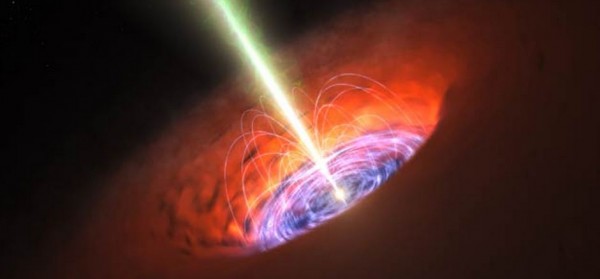Intense Supermassive Black Hole Magnetic Field Detected by ALMA
| Arthur Dominic Villasanta | | Apr 17, 2015 12:24 PM EDT |
(Photo : ESO) Supermassive black hole at a galaxy's center, an artist's illustration
An extremely powerful magnetic field beyond anything previously yet detected by astronomers has been discovered in the core of a galaxy that also has an "Einstein ring" around it.
Astronomers from Chalmers University of Technology and Onsala Space Observatory in Sweden have used the Atacama Large Millimeter/submillimeter Array (ALMA) to detect signals directly related to a strong magnetic field very close to the event horizon of the supermassive black hole in a distant galaxy named PKS 1830-211.
Like Us on Facebook
ALMA is an astronomical interferometer of radio telescopes in the Atacama Desert in northern Chile consisting of 66 12 meter (39 feet) and 7 meter (23 feet) diameter radio telescopes observing space at millimeter and submillimeter wavelengths.
This new observation helps astronomers to understand the structure and formation of supermassive black holes at the center of galaxies, and the twin high-speed jets of plasma they frequently eject from their poles.
Supermassive black holes, often with masses billions of times that of the Sun, are located at the heart of almost all galaxies in the Universe.
These black holes can accrete huge amounts of matter in the form of a surrounding disc. While most of this matter is fed into the black hole, some can escape moments before capture and be flung out into space at close to the speed of light as part of a jet of plasma.
How this happens is not well understood, although it is thought that strong magnetic fields, acting very close to the event horizon, play a crucial part in this process, helping the matter to escape from the gaping jaws of darkness.
Up to now only weak magnetic fields far from black holes have been probed.
The team measured the strength of the magnetic field by studying the way in which light was polarized as it moved away from the black hole.
"Polarization is an important property of light and is much used in daily life, for example in sun glasses or 3D glasses at the cinema," said Ivan Marti-Vidal, lead author of this study.
"When produced naturally, polarization can be used to measure magnetic fields, since light changes its polarization when it travels through a magnetized medium. In this case, the light that we detected with ALMA had been travelling through material very close to the black hole, a place full of highly magnetized plasma."
The astronomers applied a new analysis technique that they had developed to the ALMA data and found that the direction of polarization of the radiation coming from the centre of PKS 1830-211 had rotated. These are the shortest wavelengths ever used in this kind of study that allow the regions very close to the central black hole to be probed.
"We have found clear signals of polarization rotation that are hundreds of times higher than the highest ever found in the Universe," said Sebastien Muller, co-author of the paper.
"Our discovery is a giant leap in terms of observing frequency, thanks to the use of ALMA, and in terms of distance to the black hole where the magnetic field has been probed -- of the order of only a few light-days from the event horizon. These results, and future studies, will help us understand what is really going on in the immediate vicinity of supermassive black holes."
PKS 1830-211 is also notable for its Einstein ring, which is the deformation of the light from a source (such as a galaxy or star) into a ring through gravitational lensing of the source's light by an object with an extremely large mass (such as another galaxy or a black hole).
©2015 Chinatopix All rights reserved. Do not reproduce without permission
EDITOR'S PICKS
-

Did the Trump administration just announce plans for a trade war with ‘hostile’ China and Russia?
-

US Senate passes Taiwan travel bill slammed by China
-

As Yan Sihong’s family grieves, here are other Chinese students who went missing abroad. Some have never been found
-

Beijing blasts Western critics who ‘smear China’ with the term sharp power
-

China Envoy Seeks to Defuse Tensions With U.S. as a Trade War Brews
-

Singapore's Deputy PM Provides Bitcoin Vote of Confidence Amid China's Blanket Bans
-

China warns investors over risks in overseas virtual currency trading
-

Chinese government most trustworthy: survey
-

Kashima Antlers On Course For Back-To-Back Titles
MOST POPULAR
LATEST NEWS
Zhou Yongkang: China's Former Security Chief Sentenced to Life in Prison

China's former Chief of the Ministry of Public Security, Zhou Yongkang, has been given a life sentence after he was found guilty of abusing his office, bribery and deliberately ... Full Article
TRENDING STORY

China Pork Prices Expected to Stabilize As The Supplies Recover

Elephone P9000 Smartphone is now on Sale on Amazon India

There's a Big Chance Cliffhangers Won't Still Be Resolved When Grey's Anatomy Season 13 Returns

Supreme Court Ruled on Samsung vs Apple Dispute for Patent Infringement

Microsoft Surface Pro 5 Rumors and Release Date: What is the Latest?










